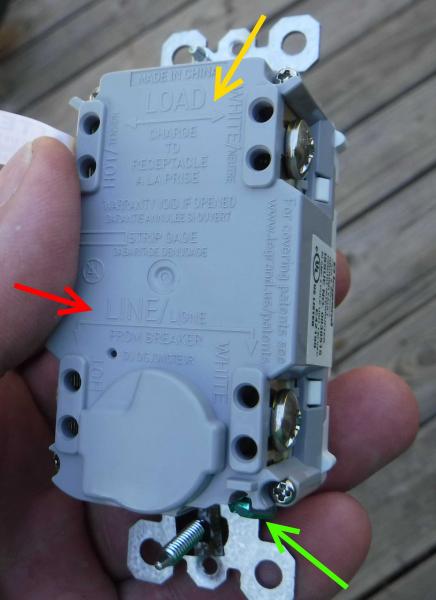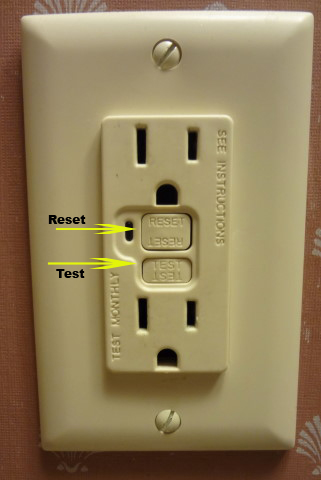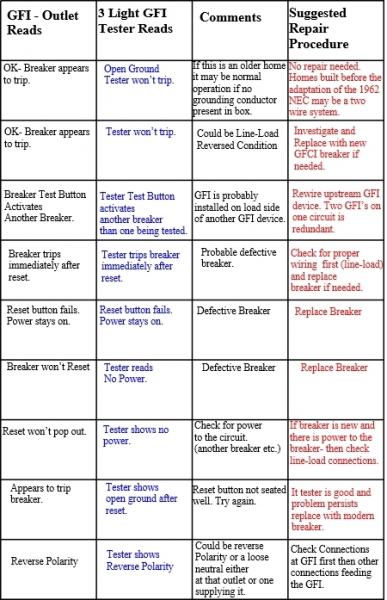- Home - Blue Palmetto Home Inspection of Summerville and Charleston
- Learn About Us and This Charleston Home Inspector
- What's Inspected
- Charleston Lowcountry Inspection Areas (geographic)
- Testimonials
- >>>Blogs (educational)
- Sample Reports & Documents
- Why Get a Home Inspection Report
- Charleston's Top Ten Reasons
- Home Inspector Photo Galleries
- Pricing
- Scheduling and Customer Information
- Home Inspection Authorization Contract
- General Scope of Work (electronic)
- Home Inspection Customer Satisfaction Survey
- Privacy Policy
- Full site
- The Roof Framers Field Manual
Charleston home inspector discusses GFI's
Submitted by Ray Thornburg on Fri, 10/05/2012 - 13:03
GFI Requirements by Year

A GFI ( ground fault interrupter) is a type of electrical receptacle which provides a greater measure of protection against electrical shock than a circuit breaker alone. It works by measuring the current flow on both the hot and neutral and it instantly cuts off the power if there is fault to ground or an imbalance. They are used where moisture is a possibility for safety purposes. As the years have passed they have been required in more and more places. While it is not required that anyone replace their existing outlets (unless you're remodeling) it is a pretty good idea. It is also a good idea to test the ones you have occasionally to make sure they still work. Below is a chart that show the approximate date of inclusion into the NEC the requirement to install GFI's. It is well to understand also that different jurisdictions adapt codes at different times ....sometimes years later so if you have a home built in '76 for instance you still may not see GFI's in the bathroom. Please consult the code books for the exact reference.
As a home inspector we always recommend installing GFI's where needed for safety. It's a great way to say "I love you" to your family.
Here is a picture of a typical ground fault circuit interrupter ( gfi ).
They should be tested occasionally to make sure they still work.
They also make a gfi circuit breaker that is installed into the panel box. they look like a regular circuit breaker with a reset button on the front to test them occasionally.
Ungrounded Wiring Systems:
GFI's can also provide protection on older ungrounded two slot receptacle locations that have no grounding conductor. In other words if an older two slot receptacle is changed out to the three slot (two plus ground) then it must be GFI protected. Must use the supplied label " No Equipment Ground, GFCI protected" to identify that the circuit has no ground. Note - A standard GFI tester will not work on these outlets because there is no grounding conductor. In this case you have to use the test button on the GFI itself to test it. Grounding conductors at outlets have been required since the adaptation of the 1962 NEC.
Other Tips:
Manufacturers recommend using the built in test button to test a GFI outlet. However after you've tested the GFI with the built in test button try using one of those three light testers as it can give you some clues as to what's going on with the wiring. We recommend this procedure.
- First- Verify power to the outlet. A three button tester will work for this. Make sure there is nothing else plugged into the outlet you are testing.
- Second- Press the reset button on the GFI. Observe what happens.
- Third- Try using a three light tester on it. Observe what happens.
- Forth- Testing for GFI protection can tell you what is going on in a circuit. For example if the dishwasher stops then you'll know that it is on the same circuit as the counter top circuit for example.
Troubleshooting Chart
I've prepared this handy chart to help troubleshoot a GFI circuit.
A word about Line Load Reversal on a GFI
A GFI has to be wired correctly to work correctly. For instance if your tests indicate a line load reversal condition then the GFI being tested will not be protected although it may appear that it works when using the test button (often it activates another GFI located on the same circuit up stream). The load side is for feeding other outlets downstream of the GFI device. The line side is how power gets to the outlet. In this case there will still be power at the GFI with the test button. Note* GFI's manufactured after 2003 cannot be reset at the GFI test location when there is a line load reversal condition thus indicating the cause of the malfunction. The problem could also be a miswired outlet on the same circuit somewhere. What ever the cause the main thing to remember is that on a grounded wiring system both the test button on the GFI and the tester should cause the GFI to trip. If it does trip but doesn't reset then suspect line load reversal.
The other situation is when a GFI causes another GFI breaker to trip. This can be inconvenient because the GFI that trips may be in a remote location. In this case it means that there is a line to load reversal problem. Solution is to use the load side when wiring downstream GFI devices. So you must identify which conductors are feeding the circuit.
 Picture at left shows how the GFI is marked so it is obvious which side is the line side and load side. The load side is for feeding other outlets downstream. In other words you must determine which wires feed the circuit and hook those up to the line side to supply the first GFI. Do this by disconnecting the old outlet and wire nut the ends of the conductors to isolate them and then turn the power on to find the "hot conductor" using a suitable tester. Then turn the power off again to wire the outlet with your new knowledge.
Picture at left shows how the GFI is marked so it is obvious which side is the line side and load side. The load side is for feeding other outlets downstream. In other words you must determine which wires feed the circuit and hook those up to the line side to supply the first GFI. Do this by disconnecting the old outlet and wire nut the ends of the conductors to isolate them and then turn the power on to find the "hot conductor" using a suitable tester. Then turn the power off again to wire the outlet with your new knowledge.
A three light tester will only test for one condition at a time. In the example at left a non contact voltage tester was used with a three light tester to determine a reverse polarity condition and an open ground condition. The hot slot is supposed to be the smaller of the two and the non contact voltage tested correctly identified the problem. This deficiency is actually fairly common on older homes.
Blue Palmetto Home Inspection serves the entire Charleston Lowcountry area!




